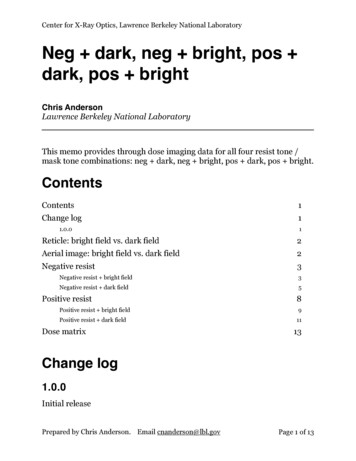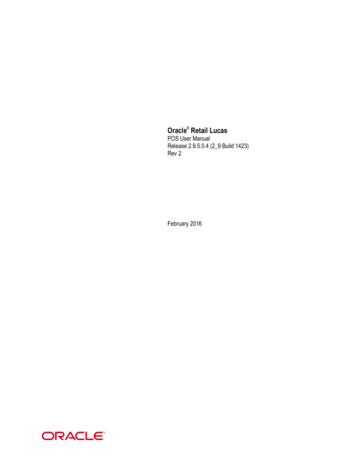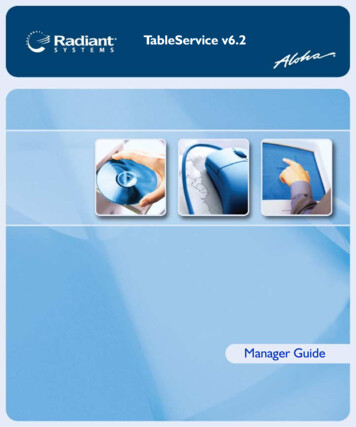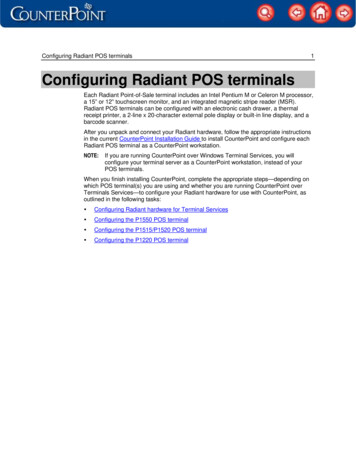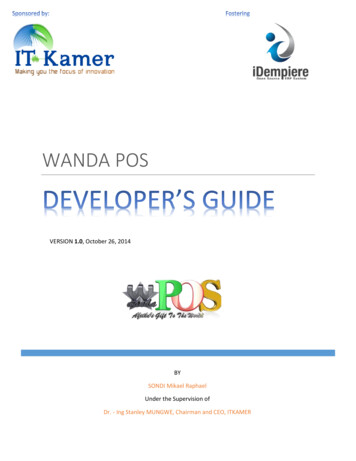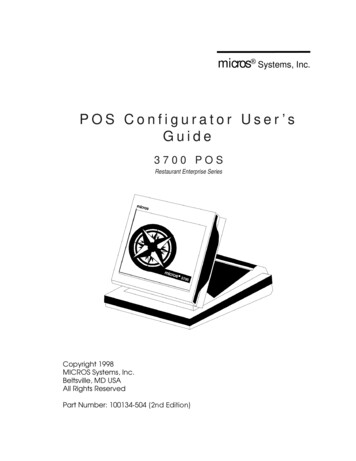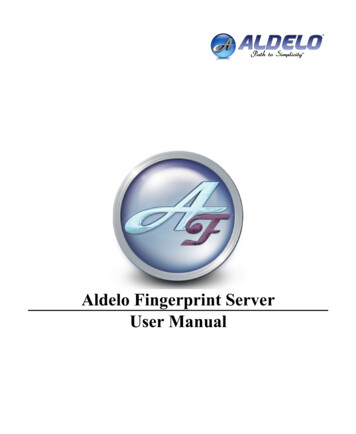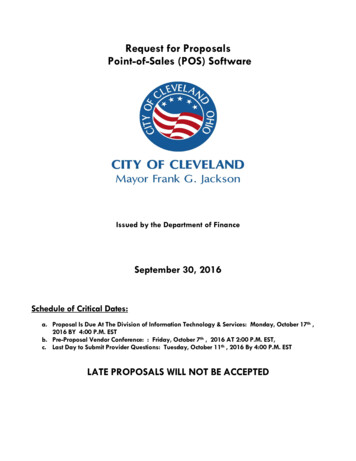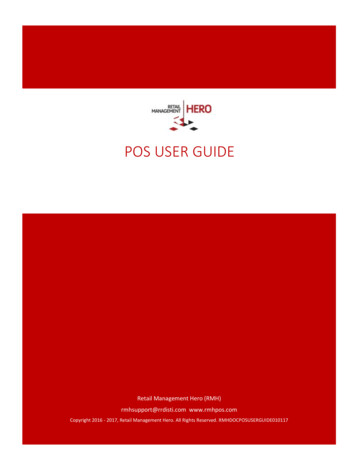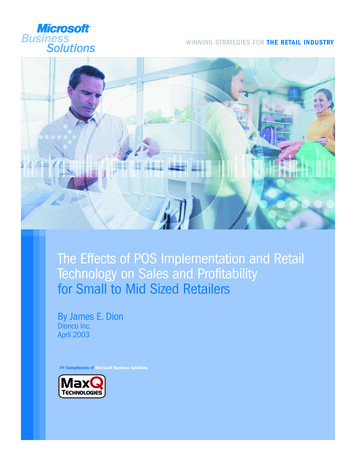
Transcription
WINNING STRATEGIES FOR THE RETAIL INDUSTRYThe Effects of POS Implementation and RetailTechnology on Sales and Profitabilityfor Small to Mid Sized RetailersBy James E. DionDionco Inc.April 2003 Compliments of Microsoft Business Solutions
Contents1Purpose1Background2Executive Summary2What A Retailer Can Expect3Data Sources3Excerpted Results of The Survey on Technology for Independent Retailers3Constraints4Findings4What Causes Increased Sales/Decreased Operating Expenses4Point-Of-Sale5Merchandise Systems6Customer Database7Point-Of-Sale System7Merchandise/Inventory Control Systems8Customer Database8Sample Performance Results9The BC Ferries Study9Overview9Results
PurposeFrom Microsoft Business SolutionsThe purpose of this white paper is to explore the impact of the deployment of technology in a retail business. More specifically, we willlook at the effects on sales, profitability and productivity of the use of Point of Sale, Inventory Control and Customer Profiling Softwarein small to mid-sized retail stores. BackgroundIt has been over 20 years since the introduction of the Personal Computer (PC). Roughly five years after its invention in 1980, retail storesbegan to put the PC to use in their stores and head offices. Prior to this development small and mid-sized1 retailers2 mainly relied on eitherelectronic cash registers that simply gave a sales total for the day or more sophisticated registers that provided sales by department reportingvia a cash register tape at the end of the day. Far too expensive for small retailers, there were also the more sophisticated registers used bylarger retailers that were connected to mini or main frame computers to track individual sales by product number.With the growing popularity of the PC, programmers started to write Point of Sale, Financial and Inventory programs for smallerretailers. The first of these systems started appearing in 1983 but were very primitive and did not provide extensive integration orfunctionality. Over the past fifteen years systems have improved dramatically and have become almost as sophisticated as large storesystems. Many of the programs now available were originally written in DOS but have been converted to the Windows operatingsystem. There is not much functionality that large stores have that is also not available today to small-to-mid-sized stores.12DSTM Department Store Type Merchandise retailers (does not include Food, Convenience or Auto)Small retailers are defined with sales under 10 million per year; mid-sized 10 to 100 million per year.The Effects of POS Implementation and Retail Technology on Sales and Profitability for Small to Mid Sized Retailers Microsoft Business Solutions1
Executive SummaryOver the past fifteen years more and more independent retailers have installed software and hardware in their stores for the purpose ofcollecting sales data (POS) and ordering and tracking inventory (Merchandise Systems) and many have also added customer profilingin the last five years.There can be little doubt that the deployment of technology in a retail store leads to higher sales, reduced expenses and increased grossmargins which have ultimately produced an increase in the overall profitability of those stores who not only have deployed the technology buthave also learned how to use it. They key to these increases is the last seven words above. Retailers who have both spent the money and takenthe time to train their people on the technology reap the benefits of that technology. Many do not adequately learn their systems and thereforedo not receive the level of performance increases that retailers who learn the systems do.Data from a 1998 Technology Study indicates that on average stores experience a minimum sales increase of 16%, with some stores experiencingup to 23%, thanks to the deployment of technology. This was for POS only, and when asked about the impact of inventory/merchandise systemsand customer databases, the sales increases were comparable in magnitude with customer database contributing to even higher sales increases.The expense savings in the study were an average of 13% after deployment of POS and slightly higher for merchandise systems (14.3%) andcustomer databases (15.7%).The most definitive study on the effects of POS deployment was a study done by BC Ferries3 in 1996 when they were able to analyze theimpact of POS by using a true control methodology that demonstrated the difference between a store with POS technology and one without.This study reported an amazing 29% increase in sales and a 34% increase in gross profit in the store with a POS system.Working with clients over the past ten years and being able to observe performance in many of them after installation of POS technology,our findings have been very similar though not as spectacular as the BC Ferries study. On average, our clients experience anywhere betweena 10% to 24% sales increase six months after installing their systems which is sustained for up to two years and then settles into a 8%to 10% increase thereafter. However, clients who have also customer databases are able to sustain larger and longer sales increasesbecause the customer profiling allows them to continue to grow their business with not only existing customers but also with new ones.What A Retailer Can Expect Given an integrated POS, Merchandise and Customer profile system that is deployed properly (which in some cases can be up to 40hours of training for management and 20 hours of training for staff but can be less if staff are computer literate) the following resultswill be possible after the first six months (it generally takes approximately six months for a system to be fully operational and for allstaff to feel comfortable using it).High Performance 4Mid Performance5Low Performance6Sales Increase 20% 10% 5%Expense Decrease– 15%– 8%– 2%Margin Increase 25% 15% 8%Net Profit Increase 30% 12% 6%BC Ferries Corporation is a British Columbia Crown Corporation that operates ferry service in the Province of British Columbia.High performance are stores that really adopt and maximize all the components of the technology (see section titled What causes increased sales/decreasedoperating expenses in this report).5Mid performance are stores that utilize most but not all of the technology.6Low performance are stores that utilize just a few components of a system.342Microsoft Business Solutions The Effects of POS Implementation and Retail Technology on Sales and Profitability for Small to Mid Sized Retailers
Expense reduction tends to be larger for smaller retailers who appear to be able to reduce one to two staff positions which in companiesof a smaller size represent a larger percentage of the overall payroll. Gross margin improvements are experienced by most users of POS andmerchandising software because markdowns are reduced and often optimum ordering quantities are achieved which leads to maximizingdiscounts from vendors.It is difficult to put a total profitability increase on all these factors, but it is safe to predict that a store can increase its net profit by atleast ten percent within a year of deploying technology and fully using it. This would translate into a substantial return on investment asthe majority of independent retailers spend about two percent of sales to acquire the technology.This study is brought to you in part by Microsoft Business Solutions and Microsoft Retail Management System. An affordable, easy-to-usesolution suite for independent merchants, Retail Management System consists of Store Operations, for tracking and expediting point-of-saleand business processes, and HeadQuarters, for managing a multi-store business from the head office. Built on powerful Microsoft technologies,backed by expert services and support, Retail Management System can help you automate and integrate information and processes toreduce costs and increase revenues across your business. Data SourcesData for this white paper was collected from over 40 Independent Retail Clients of Dionco Inc., the 1998 National Technology Study,and the 1997 BC Ferries POS Study. Excerpted Results of The Survey on Technology for Independent Retailers7This study was conducted in 1998 using a field research team that interviewed 580 Independent Retailers via phone calls that lasted on theaverage 30 minutes. These retailers were using integrated Point of Sale, merchandising (inventory control) and customer profiling software.They were probed for satisfaction with their systems as well as increases in sales and decreases in operating expenses. This study did rely onthe opinion of the retailer and clearly has a margin of error based on the fact that sales increases (although documentable) could not betotally attributed to the deployment of technology. The study also found that the newer the system, the lower the sales increases attributed tothe technology, and also a high correlation with low sales increases and dissatisfaction with the technology.And although the study is now almost 5 years old, the results would likely be even more impressive today as software has gained somuch additional functionality over this time frame. ConstraintsIn examining the impact of the deployment of technology in a scientific manner the major constraint is the impact of intervening variableson the results that are produced. For example, if we take a stores sales before the introduction of a POS system or inventory system and thenmeasure the results a month or year later one could easily argue that any sales increases, expense reductions or profit increases could havebeen caused by other factors such as the economy, the “Hawthorne Effect”8 , or even random chance. These other factors, known as interveningvariables, cloud the results and make it very difficult if not impossible to assign any results to a specific cause. The only study to overcome thisproblem was a study done by BC Ferries Corporation in 1996 which allowed the use of a true control and experimental environment. Details ofthis study are in the body of this report.Another constraint is that the Independent Retail community has not been studied in a disciplined manner by any organization and manyIndependent Retailers are hesitant to share any financial or operating data with outside groups. While it is true that many associations haveconducted benchmark data analysis of members’ performance, no studies have attempted to quantify the results of the deployment oftechnology with the exception of the study done by a National Retail Association in 1998 where 580 Independent Retailers were interviewed todetermine their satisfaction and results using technology in their stores. Results from that groundbreaking study will be quoted later in this report.78A Report on the Research For The Independent Retailers Solution, 1998The Hawthorne Effect is a well known experiment conducted at the Western Electric Plant in 1929 that demonstrated significant changes in output basedsolely on workers perceptions and not on any real changes to work flow or practices.The Effects of POS Implementation and Retail Technology on Sales and Profitability for Small to Mid Sized Retailers Microsoft Business Solutions3
FindingsBased on the data examined, the deployment of technology leads to sales increases and expense reductions which positively impactprofitability. But how does technology accomplish all this? Technology by itself does not cause sales increases or expense reductions,but rather the way the information that technology provides is used causes the increased sales and reductions in expenses.Not every retailer experiences sales increases or cost savings on all the factors. Many are dependent on how the individual retailer uses thetechnology. For example, a pure fashion retailer may not get relevant benefits from automatic replenishment as fashion changes so often thatmost purchases are not replenishment of existing product but rather new product. This hypothetical fashion retailer however, would reapextensive benefits from fast/slow seller reporting as well as a suggested item feature in the POS systems.It is also interesting to note that in the area of expense reductions, for some, the first six months expenses may actually increase! Although thisis not universal. This is caused by the extra time required to learn the new systems and to integrate them into the store. Often during this period,extra staff and hours are used to fully implement the technology, but after six months most retailers find that they are able to reduce at leastone if not two full time clerical people and often they reassign these hours to the sales floor. What Causes Increased Sales/Decreased Operating Expenses:Point-Of-Sale Faster check out of customers by scanning items increases throughput of customers at the cash register. At busy times this reducesthe chances of a customer seeing a long line and not making a purchase. Faster approval of charge purchases via either dial up or always on connection increases the speed of the transaction therebyreducing the chance of a customer seeing a long line and not making a purchase. Accurate capture of the exact item detail being sold in combination with suggested re-order software increases the in stock position ofmerchandise. This ensures sales are not lost due to out-of-stock merchandise and ultimately leads to an increase in total sales. Software with related item or suggested item prompts (when an item is scanned, if there is a related or add-on item available, thesoftware will prompt the sales associate to ask the customer if they would like the additional item) which leads to increases in averagetransaction value. The Transaction Suspend feature will place a transaction in suspense while the customer either goes to their car to get their check orcharge card or goes back to the store to get an additional item and resumes the transaction when the customer returns. This speedsup processing of customers in line behind this customer and reduces waiting time. It also makes it easier for a customer to add onitems to their purchase. Production of “Gift Receipts” which identify the transaction number and make returns much more accurate by identifying the sellingprice and method of payment when an item is returned or the storage of exact transaction detail permitting the reprinting of a receipt.These receipts can even be tied to a bar coded sticker that is placed on the item making return tracking even more accurate andreducing loss from too high a refund or reducing customer dissatisfaction with the returns process. Automatic store credits can be given on returned items which reduces cash refunds and tracks returned items. These store credit notesare serialized and can be used just like a gift card and often small credit balances either are not used or lead to larger sales when theyare redeemed. They also replace manual issuance of store credit notes which are time consuming and open to fraudulent use. Many systems allow the sales associate to view, right on the POS screen, average transaction and items per ticket data for the currentshift. This allows feedback to the sales associate and encourages them to suggestion sell to ensure they meet or exceed the averagesale amount, thereby increasing the likelihood of add on sales. Some systems produce this information in a separate report which isjust as valuable.4Microsoft Business Solutions The Effects of POS Implementation and Retail Technology on Sales and Profitability for Small to Mid Sized Retailers
The cash register receipt can be programmed to provide a “bounce back” coupon to the customer. This will give them a discount ontheir next purchase, thereby increasing the likelihood of a repeat purchase. By using the multi media capabilities of many new systems, sales associates can receive product knowledge training right on the cashregister which increases their knowledge and ability to sell more products and better satisfy their customers. Most POS systems make the sales associate do what is termed a “blind reconciliation” at end of day which reduces the occurrence of theft. Capture of customer information enables after-marketing to individual customers based on purchase habits and practices. This formof micro marketing is becoming more prevalent and can significantly increase a stores business. Every transaction is time stamped and retailers can run reports that identify the peak selling hours and increase staff for those timeswhich leads to better customer service and increased sales. Sales associates “clock in” on the cash register and this tracks their work hours. Time and money are saved by not having to manuallytrack hours. This information can then be exported to payroll systems which reduces the need for additional clerical staff.Merchandise Systems With data from POS the merchandise systems can ensure the proper level of inventory and the proper mix. This increases the productivityof the inventory and not only leads to sales increases (being in stock on what is selling) but also significant cost savings on inventorycarrying charges and improved cash flow which in turn increases profitability by increasing payment discounts. Suggested Re-Order can vastly improve the in stock position of core merchandise and not only increase sales but also significantlydecrease operating expenses by not having to assign staff to count on hand and manually prepare purchase orders. Slow and fast seller reports help retailers identify what is not selling so early markdowns can be taken (an early markdown reduceslosses by clearing the item in season often at a much lower discount than later in the season). As well, it can identify other problems withmerchandise (incorrect pricing, poor placement in store, breaking size/color problems etc.) and give the store a chance to correct thoseproblems instead of taking a markdown. Fast seller reports tell a retailer when to increase inventory to meet high demand therebyincreasing sales. Open to buy budgets help identify the overall inventory requirements of the store and maintain a balanced inventory that meets customerdemand so you never have too little or too much inventory. Open to Buy has to be done outside the retail software as it is a “what if”exercise but good open systems allow for export of the required data to a spread sheet for the calculation of OTB. Purchase order generation can save hours of manual writing of purchase orders and ensure timely ordering and receiving ofmerchandise, thereby increasing in stock on desired items. Purchase order receiving can save time and expenses on receiving an order into the store. By receiving by exception a retailer can expeditethe receiving process and ensure that the proper price is placed on the item. Receiving systems send data to ticket printers so pricing isfaster and more accurate. TTS (Time To Shelf) is reduced dramatically so merchandise is available for sale sooner. Purchase orders and order confirmations can be executed via Electronic Data Interchange (EDI). Retailers who use this function cansave considerable time and money by transmitting their orders directly to suppliers who then return an order confirmation that can tellthe retailer when and if they will get the products ordered (if they cannot get the products they can replace the order with another vendoror for another item which can dramatically reduce out of stocks). Many vendors today will accept email purchase orders and confirmavailability within days.The Effects of POS Implementation and Retail Technology on Sales and Profitability for Small to Mid Sized Retailers Microsoft Business Solutions5
Customer Database Customer purchase history is tracked by the system allowing the store to query data for specific items and advertise very costeffectively to individual customers. For example, a retailer
The most definitive study on the effects of POS deployment was a study done by BC Ferries3 in 1996 when they were able to analyze the impact of POS by using a true control methodology that demonstrated the difference between a st
